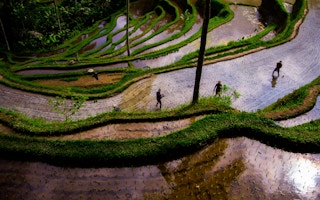At the beginning of November last year, Tamami’s rice field lay vacant except for a herd of cattle grazing on the land. Like many rice farmers here on Buru Island in Indonesia’s eastern Maluku region, 53-year-old Tamami set aside his field after the availability of water dried up.
“There’s no rain,” Tamami told Mongabay Indonesia in Savana Jaya village. “The reservoir is empty because of the long dry season.”
In a normal year, rice farmers begin planting the third and final rice crop of the year in October and November. But the emergence of the El Niño climate pattern made 2023 the hottest year on record, and extended Indonesia’s main dry season beyond October.
Sutiah, a farmer from Waitele village, said planting on her 4 hectares (10 acres) of rice fields had failed owing to the extreme weather and water scarcity. The write-off will cost her family tens of millions of rupiah, she said.
“What’s going on with this weather?” she asked.
Indonesia’s meteorology agency, the BMKG, documented extremely low levels of rainfall in much of eastern Indonesia during the second half of 2023, including on the island where Sutiah and Tamami grow rice. From August to October, monthly rainfall in the Maluku region was consistently recorded in the low range of 0-100 millimetres (0-4 inches).
Yeli Sarvina, a climate researcher at Indonesia’s national research agency, BRIN, said drought had decimated rice harvests across Buru Island.
Going against the rain
An El Niño occurs when water temperatures in the tropical eastern Pacific Ocean rise by 0.5° Celsius (0.9° Fahrenheit) above the long-term average temperature.
In Indonesia, the phenomenon leads to a sweltering dry season that fuels wildfires and dries up water bodies across much of the archipelago of 275 million people, including the reservoirs that Sutiah and Tamami rely on to irrigate their food crops.
Prices for medium-grade rice in November spiked by 25 per cent over the government’s recommended retail price.
At the onset of the rainy season in December, President Joko Widodo urgently seconded military personnel to pitch in with rice planting to boost supplies.
Research by scholars at Pattimura University in Ambon, the capital of Maluku province, measured groundwater in the Waeapo area of Buru Island over a 30-year period to document changes wrought by both El Niño and La Niña (which in Indonesia brings opposing conditions of increased rainfall).
“[D]uring El Niño rainfall conditions, there was an annual groundwater deficit of 403 mm [15.9 in] or 172 per cent of normal conditions, whereas during La Niña rainfall conditions there was a surplus of annual groundwater of 775 mm [30.5 in] or 222 per cent of normal conditions,” the study concluded.
The researchers found that the cultivation period for rice during La Niña was uninterrupted year-round, but that rice could be produced only between January and May during an El Niño year.
In recent decades, these climatic phases accompanied by intense and extreme weather have occurred with greater frequency, elevating risks facing tens of millions of rice-farming families across Southeast Asia as climate change strengthens.
High and dry
Waeapo is a hilly agricultural area on Buru Island, where the subdistrict’s 3,326 hectares (8,218 acres) of rice fields are pivotal to families’ food security and livelihoods.
“There has been no rainfall,” said Supri, an agricultural extension worker in Buru. “Farmers can’t work on their fields for the third planting season.”
Buru farmers say water stress on the island is inflaming tensions within communities.
Rice farmer Sarno said he was forced to stay up at night to ensure he could access water, and to prevent theft of water from his land.
“Apart from regularly staying up late, you have to have the courage to argue in order to get your turn for water,” he said.
In Parbulu village, risks of violence simmered until local farmers formed an agreement to take turns to use irrigation to supply their rice fields.
“Due to this water shortage, rice planting in several rice fields has been delayed,” said Temok Karyadi, head of the Buru district agriculture department.
In Waekasar village, farmers rely on wells drilled by the government, while others have taken their fate in their own hands, pumping water themselves from available sources.
“The crop is ruined,” Sutiah said. “2023 has been very difficult. We’ve had no rain for four months.”
This story was published with permission from Mongabay.com.

















